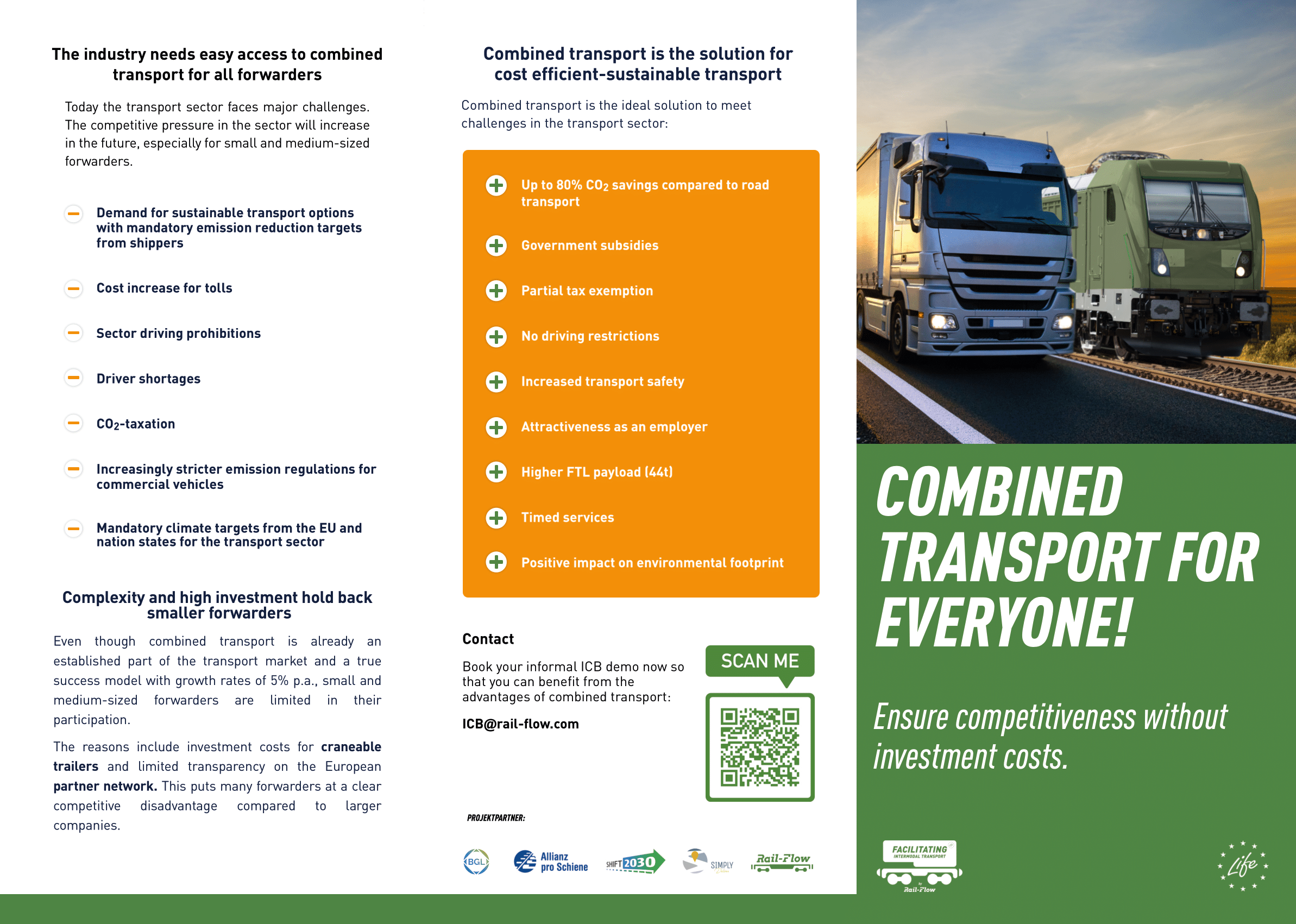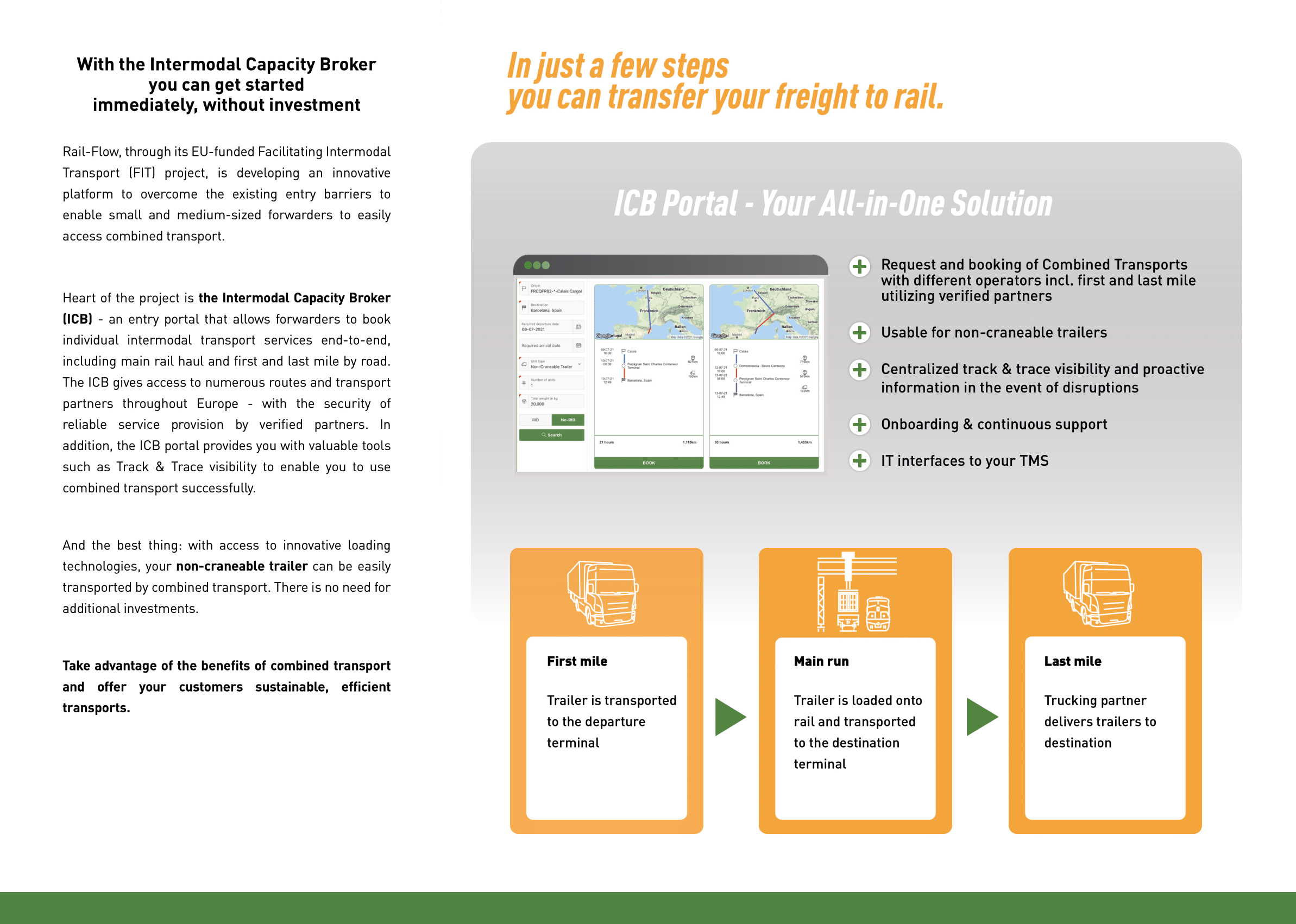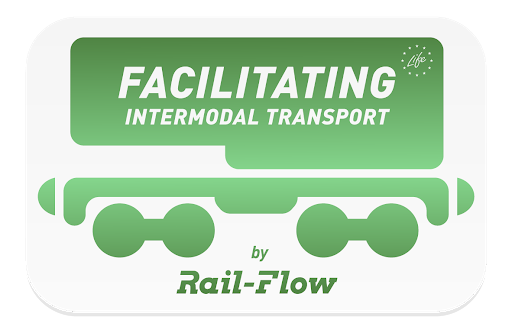Topic outline
-

 Background
BackgroundThe transport sector is one of the fastest-growing industries in the EU. Road transport accounts for more than 70% of EU's freight transportation and causes severe environmental problems by emitting several million tons of greenhouse gases and air pollutant emissions each year into the atmosphere. Intermodal freight transports combine the advantages of road and rail transport, thereby reducing air pollution by 2/3 compared to road-only transportation. But the existing systems for purchasing and selling in the intermodal freight transport sector are non-transparent as well as too expensive and complex for SMEs.
Digitalisation, especially providing easy-to-use broker solutions of those processes will enable SMEs to increase their use of rail instead of road, leading to several socio-economic and environmental benefits, including the reduction of air pollutants such as NOx and PM.
ObjectivesThe LIFE FIT project will contribute to the reduction of transport-related air pollution in the EU by shifting freight volumes from road to more sustainable rail transportation and by helping to decouple the environmental impacts of transport from economic growth. LIFE FIT will significantly enhance the efficiency and sustainability of EU freight transport by combining intermodal technologies with an innovative logistic broker platform allowing specifically SMEs to book end-to-end intermodal transports in Europe. The project aims to:
- Overcome the entry barriers by providing a state-of-the-art intermodal capacity broker platform including the booking of the first and last transport mile combined with the usage of intermodal loading technologies like NiKRASA as facilitator.
- Enable collaboration among SMEs active in the transportation sector
- Demonstrate cost-neutrality of intermodal transport via FIT compared to road-only transportation
- Significantly increase the share of intermodal transport for participating transport companies, mainly SMEs, along demonstration routes
- Reduce transport-related pollutant emissions and the consumption of energy and other resources as well as improve social aspects in the logistic sector, such as working conditions and fair competition
- Carry out environmental impact analyses
- Encourage digitalisation and enable for large scale volume/network effects within the transport sector to achieve health and environmental benefits
- Conduct a feasibility study for modal interoperability with waterway transports, assessing multiple environmental and other spill-over effects
- Engage the target audience and stakeholders to reach a critical mass for building a large European intermodal transport network
- Set a standard in land freight transport, serving as best practice in the sector.
Expected results: Technical-economic results:
- Facilitation of intermodal freight transport along the European West-East axis and starting the replication to the North-South axis and to the Central Europe-Turkey corridor
- Integration and optimisation of the FIT logistic platform module to allow for an end-to-end solution for intermodal transport usage by finding missing last-mile partners and enabling easy management of intermodal transports
- Demonstration of the efficiency of the intermodal loading technologies like NiKRASA in combination with the FIT platform to improve intermodal management procedures and increase safety and fair competition within the transport sector
- Operation of around 15.000 shipments via FIT by 2024 along the demonstration routes
- Creation of 10 jobs by the end of the project and 50 jobs by 2029
- Having a strong FIT network of registered customers and transport companies in 2024 with a strong focus on SMEs.
Environmental results:- Movement of freight from road to rail will result in savings of at least 17.6 million km of road transport by 2024
- Significant reduction of main air pollutants as a consequence of higher rail share by 2024 of 9.9 t VOC, 14.7 t NOx and 3.5 t SO2 (95%, 59%, and 28%, respectively) and by 2029 of 38.2 t VOC, 56.8 t NOx and 13.7 t SO2
- Reduction of carcinogenic substance PM by 112.4 kg by 2024 and 417.2 kg by 2029
- Energy savings of 351 768 720 MJ by 2024 and 1 365 700 GJ by 2029, amounting to a 70% reduction in consumption of resource
- Fuel savings of 5 million litres diesel by 2024
- Emissions savings of 33,828 t GHG (82% reduction) by 2024.
Business:- Promotion of FIT for a market-wide uptake by starting replication along the North-South-axis and Central Europe-Turkey corridor to increase the environmental impact of FIT
- Development of a transfer strategy for other transport modes such as barges, including feasibility studies
- Broad dissemination actions involving a wide stakeholder community through cooperation with national and international logistics sector organisations, the scientific community, environmental organisations, public authorities, and policymakers
- Significant company growth and job safeguarding in transport SMEs and intermodal operators, increase of competitiveness of small transport companies by increasing driver job attractiveness via FIT.
-
Forum

